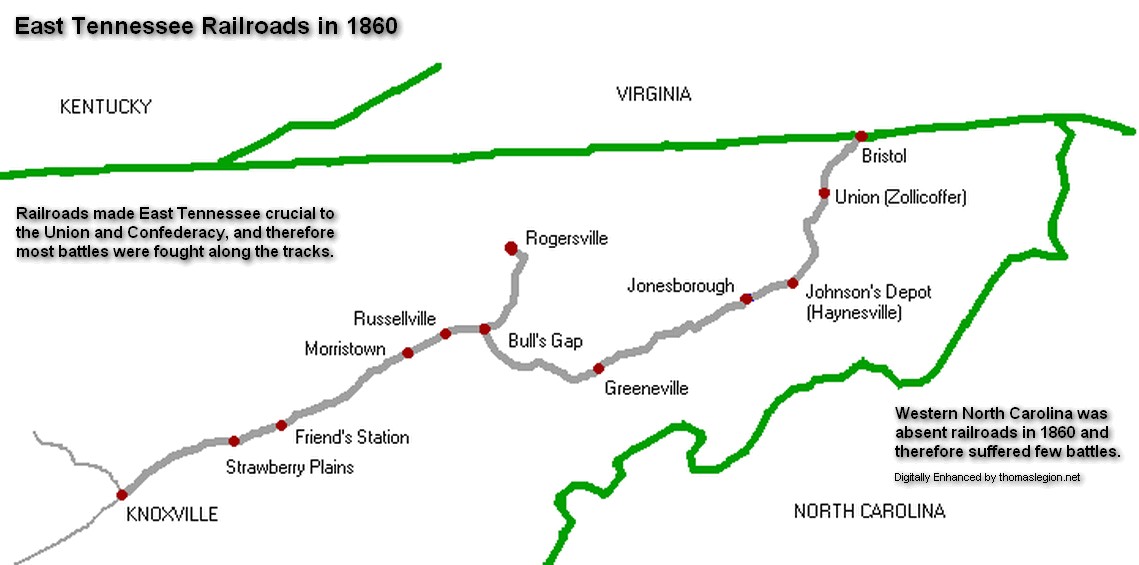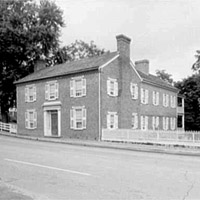|
Tennessee and the Civil War
Tennessee and the Three Grand
Divisions
| East Tennessee Civil War History Map |

|
| East Tennessee Railroads and the Civil War Map |
| Tennessee |

|
| Civil War History |
East Tennessee is the name applied to approximately the eastern
third of the state of Tennessee. Unlike the names bestowed to regions or portions of many U.S. states, the term
East Tennessee can be precisely defined. It is the portion of the state located within the Eastern Time Zone
and four counties in the Central Time Zone, namely Bledsoe, Cumberland, Marion, and Sequatchie counties. East Tennessee
is noted for its mountains, particularly the Great Smoky Mountains portion of the Appalachian Mountains. The East Tennessee
Region is also known for being the birthplace of country music and the State of Franklin.
Contrary to most geographic regions within the United States, the term
East Tennessee has legal as well as socioeconomic status. East Tennessee, with Middle Tennessee and West Tennessee,
comprises one of the state's three Grand Divisions. According to the Tennessee State Constitution, no more than two of the Tennessee
Supreme Court's five justices can come from any one Grand Division. A similar rule applies to certain commissions and boards,
to prevent them from reflecting a geographic bias.
The major cities of East Tennessee are Knoxville and Chattanooga. Other important
cities include the "Tri-Cities" of Bristol, Johnson City, and Kingsport located in the extreme northeastern area of the
state. It is an area previously and traditionally referred to by residents as Upper East Tennessee, although today the
term Northeast Tennessee is preferred by non-residents.
| Greeneville, Tennessee |

|
| Location of Greeneville, TN, Map |
During Secession, Andrew Johnson was the only Southern United States Senator
who refused to resign.
During the secession crisis, Andrew Johnson remained in the United States Senate even when Tennessee seceded, which made him a hero in the
North and a traitor in the eyes of most Southerners. In 1862, President Lincoln appointed him Military Governor of Tennessee,
and Johnson used the state as a laboratory for Reconstruction. In 1864 the Republicans, contending that their National Union Party was
for all loyal men, nominated Johnson, a Southerner and a Democrat, for Vice President. (Right) Greeneville, located in East Tennessee,
was the hometown of President Andrew Johnson and it was also known for its pro-Unionism.
During the Civil War, East Tennessee
was the poorest of the State's three Regions. Within Tennessee, East Tennessee had the least amount of slaves
based on a percentage and numerical basis. Consequently, the Region witnessed divided loyalties, and bushwhackers, outlaws
and lawlessness reigned. Many East Tennesseans served in Western North Carolina Civil War regiments. Bordered with Western North Carolina, the two Regions reflected many similarities:
Western North Carolina was the poorest of North Carolina's three Regions; both were rugged mountainous Regions; within North Carolina, Western North Carolina possessed the least
amount of slaves; both Regions experienced lawlessness and anarchy during the Civil War; and they experienced many battles
and skirmishes against the same Union commands.
| Andrew Johnson residence in Greeneville |

|
| Library of Congress |
It "was a running fight for ten miles. Two Federals were killed
in the yard of Senator Patterson, the son-in-law of President Johnson. Twelve or fifteen others were killed. General Williams, while slowly
retreating before [Union General] Burnside, heard our artillery open upon the enemy. Dashing forward at a gallop, he materially
aided us in the achievement of one of the most brilliant retreats of the war." Lt. Col. William W. Stringfield while fighting Burnside's army at the Battle at Henderson's Mill on October 11, 1863
East Tennessee proved invaluable in the defense of the vital and strategic Saltworks
and railroads. For example, while guarding the Strawberry Plains Bridge, the Thomas Legion's Private James Keelan was posthumously awarded the rare Confederate Medal of Honor. The East Tennessee and Western North Carolina mountains were also in striking distance
of several major Civil War battles. See also Tennessee Civil War History.
According to John L. Ransom, Andersonville Diary (1881),
pp. 20-21, Madame Collier was a federal soldier from East Tennessee who enjoyed army life until
her capture and subsequent imprisonment at Belle Isle, Virginia. She decided to make the most of the difficult situation and
continued concealing her gender, hoping for exchange. Another prisoner learned her secret and reported it to Confederate authorities,
who sent her North under a flag of truce.
The East Tennessee area has four seasons with mild Springs and Falls. Summers
can be hot and humid with highs in the 80s and 90s. Winters are usually mild with daily averages in the 30s, but temperatures
can drop to the 20s on occasion.
Recommended Reading:
East Tennessee and the Civil War
(Hardcover) (588 pages). Description: A solid social,
political, and military history, this work gives light to the rise of the pro-Union and pro-Confederacy factions. It explores
the political developments and recounts in fine detail the military maneuvering and conflicts that occurred. Beginning with
a history of the state's first settlers, the author lays a strong foundation for understanding the values and beliefs of East Tennesseans. He examines the rise of abolition and secession, and then advances into
the Civil War. Continued below...
Early in the
conflict, Union sympathizers burned a number of railroad bridges, resulting in occupation by Confederate troops and abuses
upon the Unionists and their families. The author also documents in detail the ‘siege and relief’ of Knoxville.
Although authored by a Unionist, the work is objective in nature and fair in its treatment of the South and the Confederate
cause, and, complete with a comprehensive index, this work should be in every Civil War library.
Advance to:
Recommended Reading: Mountain Rebels:
East Tennessee Confederates and the Civil War, 1860-1870 (240 pages) (University
of Tennessee Press). Description:
In this fine study, Groce points out that the Confederates in East Tennessee suffered more for the ‘Southern Cause’
than did most other southerners. From the first rumblings of secession to the redemption of Tennessee
in 1870, Groce introduces his readers to numerous men and women from this region who gave their all for Southern
Independence. Continued below...
He also points out that East Tennesseans were divided in their loyalties and that slavery played only a small role.
Groce goes to great lengths to expose the vile treatment of the Region’s defeated Confederates during the Reconstruction.
Numerous maps, pictures, and tables underscore the research.
Recommended Reading: War at Every Door: Partisan Politics and Guerrilla Violence
in East Tennessee, 1860-1869. Description: One of the most divided regions of the Confederacy, East
Tennessee was the site of fierce Unionist resistance to secession, Confederate rule, and the Southern war effort.
It was also the scene of unrelenting 'irregular,' or guerrilla, warfare between Union and Confederate supporters, a conflict
that permanently altered the region's political, economic, and social landscape. In this study, Noel Fisher examines the military
and political struggle for control of East Tennessee from the secession crisis through the
early years of Reconstruction, focusing particularly on the military and political significance of the region's irregular
activity. Continued below...
Fisher portrays in grim detail the brutality and ruthlessness employed
not only by partisan bands but also by Confederate and Union troops under constant
threat of guerrilla attack and government officials frustrated by unstinting dissent. He demonstrates that, generally, guerrillas
were neither the romantic, daring figures of Civil War legend nor mere thieves and murderers, but rather were ordinary men
and women who fought to live under a government of their choice and to drive out those who did not share their views.
Recommended Reading: The
Last Confederate General: John C. Vaughn and His East Tennessee Cavalry (Hardcover). Description: John Crawford Vaughn was one of the most famous men in Tennessee in the mid-nineteenth century. He was the first man to raise
an infantry regiment in the state--and one of the very last Confederate generals to surrender.
History has not been kind to Vaughn, who finally emerges from the shadows in this absorbing assessment of his life
and military career. Making use of recent research and new information, Larry
Gordon’s biography follows Vaughn to Manassas, Vicksburg
and other crucial battles; it shows him as a close friend of Jefferson Davis, and Davis’s
escort during the final month of the war. Continued below…
And it considers his importance as one of the few Confederate generals to
return to Tennessee after Reconstruction, where he became President of the State Senate. Gordon examines Vaughn’s
(hitherto unknown) location on the field of crucial battles; his multiple wounds; the fact that his wife and family, captured
by Union soldiers, were the only family members of a Confederate general incarcerated as hostages during the Civil War; and
the effect of this knowledge on his performance as a military commander. Finally, the book is as valuable for its view
of this little understood figure as it is for the light it casts on the culture of his day. Reviews: Modern reappraisals of
maligned Civil War figures like Confederate General John Crawford Vaughn often attempt to even the score by either going too
far in the other direction or attacking the subject's critics. Fortunately, Charles Larry Gordon's The Last Confederate General
avoids such tactics, and instead attempts a balanced, 'warts and all' portrait of the man…The Last Confederate General
is a largely sympathetic, yet even handed, appraisal of the checkered military career of John C. Vaughn. In addition to the
narrative account of the general's military service, the lengthy biographical sketch is useful, both as a portrait of a neglected
Civil War figure and a personalized example of the deep divisions within East Tennessee politics and society.--Civil War Books
& Authors. The Last Confederate General is a fine read for anyone: Action, adventure, love, drama, war and perseverance.
What more can you ask for in a book. Five stars for Larry Gordon for a job well done…Larry Gordon seemed to have nailed
both recreational reading and historically accurate statistics in one read….a fascinating story of courage, determination
and self worth.--Our History Project
Recommended Reading:
Touring the East Tennessee Backroads (Touring
the Backroads) (380 pages) (John F Blair Pub; 2 edition) (October 1, 2007). Description: The historical facts in the first edition of Touring the East Tennessee Backroads have
not changed much since the book was first published in 1993, but highway construction and development has altered the routes
of the 13 tours. Continued below...
For
this second edition, the author drove over 3,000 miles to update the tours where people such as Daniel Boone, Davy Crockett,
Sam Houston, Andrew Jackson, Sequoyah, Nancy Ward, and Clarence Darrow once traveled the same backroads.
Recommended Reading: The Loyal Mountaineers Of Tennessee (1888)
(Hardcover: 426 pages) (Kessinger Publishing, LLC) (June 2, 2008). Description: This
book defines the importance of East Tennessee and its residents to the Union cause during the Civil War. The author begins with early
history of East Tennessee and the events which led to the War Between the States. He continues
by describing local people and events that contributed to the decision to remain loyal to the United States. Continued below...
The events of the War as they involve East Tennessee are detailed, including important meetings and battles
such as Carter's Raid and the siege of Knoxville. The text is enhanced with illustrated portraits of East Tennessee individuals who contributed to the Civil War effort. Originally written and
published in 1888, this reprinted edition is accompanied by a complete index. This book is a valuable addition to both the
Tennessee historian and the Civil War buff.
|

